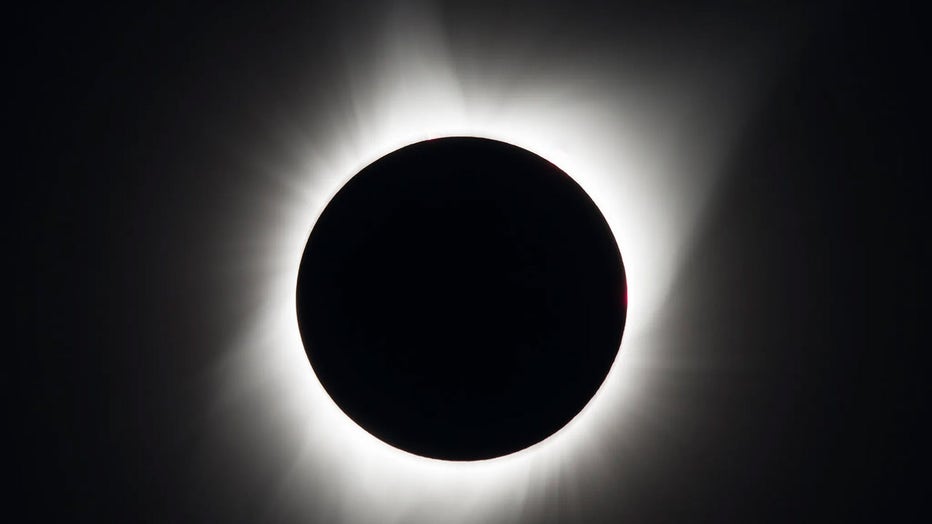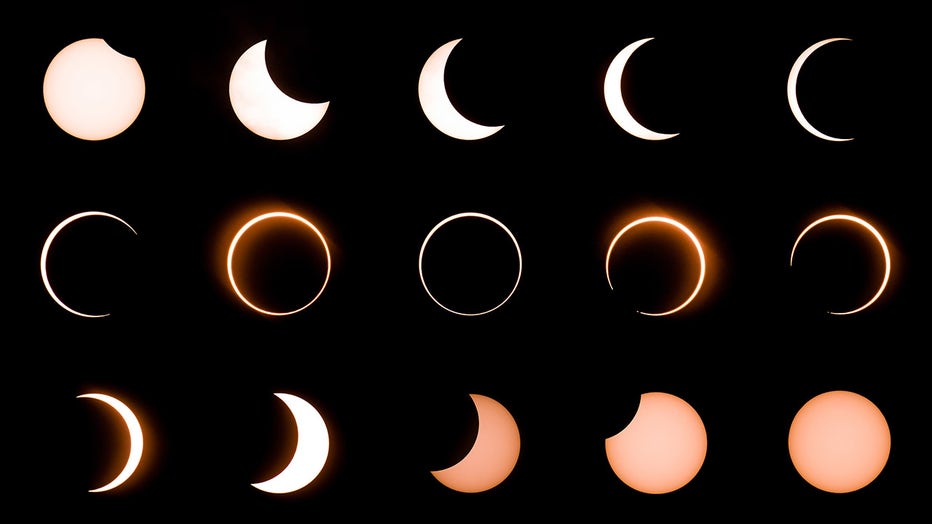Solar eclipse countdown: What to know with 1 week to go

Anatomy of a solar eclipse
FOX 4's Dan Henry breaks down what exactly will happen during the total solar eclipse on April 8. (Video courtesy of FOX 4 Dallas)
The total solar eclipse on April 8, 2024 is now just a few days away. Millions of people will be able to step outside and see a very rare spectacle: The moon moving in front of the sun, either partially or completely blocking its light.
Here's what you need to know to enjoy the event.
Total solar eclipse path
The April 2024 solar eclipse will be visible, at least in part, to nearly everyone in the U.S. But the path of totality – where the moon will completely block the sun – is a 115-mile-wide region that stretches from southern Texas up through Ohio, then over to northern Maine.
Large cities in the path of totality include:
- Austin, Texas
- Dallas, Texas
- Little Rock, Arkansas
- Carbondale, Illinois
- Indianapolis, Indiana
- Cleveland, Ohio
- Buffalo, New York
- Plattsburgh, New York
- Presque Isle, Maine
The farther you are from that path, less and less of the sun will appear to be blocked.
What time is the solar eclipse?
Southern Texas will see the peak of totality first, around 1:30 p.m. Central Daylight Time. Then Dallas at 1:42 p.m., with the time getting later and later as the moon’s shadow moves north. Indianapolis will see the peak around 3:05 p.m. Eastern Daylight Time; Cleveland at 3:15 p.m., and northern Maine around 3:30 p.m.
However, it will take several hours for the moon to move across the sun, so the actual eclipse event will start just over an hour before the peak of totality, with more and more of the sun slowly being blocked.
How long is the solar eclipse?
Again, that depends on where you are. Those closest to the center of the path will see total darkness for about four minutes at the peak of totality.
But because the moon moves slowly across the sun’s path, the entire eclipse event – from when the moon first clips the sun until the time it clears – will last from 90 minutes to over two hours for those in the path of totality.
Astronaut's perspective on the solar eclipse
Would you rather see an eclipse from space or from here on Earth? In this interview facilitated by Sonic, here’s the perspective of Col. Terry Virts, one of the few human beings who has done both.
Where do I look for the solar eclipse?
The easiest way to know may be to step outside in the days leading up to the eclipse and see where the sun is during the afternoon.
Early afternoon on April 8, the sun will be pretty high in the sky. As always, though, the further north you are, the lower in the sky the sun will appear.
MORE: How to get the best view of the solar eclipse
For example, in Austin, the sun will be at 67 degrees up from the horizon at the peak of totality. Remember, 90 degrees is straight up, so 67 degrees is just over two-thirds up into the sky from the horizon.
In Cleveland, meanwhile, the sun will be slightly lower, at only 49 degrees – just over halfway up in the sky.
What will I see during the eclipse?

The total solar eclipse on Aug. 21, 2017, was photographed from Madras, Oregon. The black circle in the middle is the Moon. Surrounding it are white streams of light belonging to the Sun’s outer atmosphere, called the corona. (NASA/Aubrey Gemignani)
If you are in the path of totality: The moon will appear to completely block the sun for as long as seven and a half minutes. Daytime will turn into near night during that time and the sun’s corona – the outer rays – may be visible.
If you are not far from the path of totality: The moon will appear to block most of the sun. It will still become noticeably darker; daylight will become more like twilight.
If you are well outside the path of totality: You’ll notice a chunk of the sun is being blocked. The farther away you are, the smaller the moon’s bite will appear to be. In Seattle and Portland, Oregon, about as far away as you can get in the continental U.S., one-third of the sun will be swallowed.
Where can I get eclipse glasses?

Eye protection for April's total solar eclipse
If you?re among the millions of people who will get the chance to witness April?s total solar eclipse, you?re going to want to use eye protection. Vitreoretinal surgeon at New York Eye and Ear Infirmary of Mount Sinai Dr. Avnish Deobhakta joined FOX Weather on Sunday to explain the dangers of viewing the eclipse without proper eye protection.
Solar eclipse glasses are essential if you want to look at the eclipse itself. Even with the moon partially blocking it, the sun will still be strong enough to damage your eyes.
Many businesses are giving away glasses for free; you can find a list here.
If you can’t get eclipse glasses, welder’s glasses can work but only if they are rated with the darkest shade level of 14.
An eclipse viewing box, which projects a shadow of the eclipse, may be a safer option for young children. Here’s how to make one.

File: This composite image shows the moon as it moves in front of the sun in a rare "ring of fire" solar eclipse as seen from Tanjung Piai in Malaysia on December 26, 2019. (Photo by SADIQ ASYRAF/AFP via Getty Images)
How to know if your eclipse glasses are safe
Solar filters are used in eclipse glasses and handheld viewers and meet a very specific worldwide standard known as ISO 12312-2.
For a list of verified eclipse glasses and viewers, click here.
When is the next total solar eclipse?
After 2024, NASA says, the next total solar eclipse visible from any point in the contiguous United States will occur in 2044. Totality will only be visible from North Dakota and Montana.
The next total solar eclipse that will travel across the lower 48 states from coast to coast is in 2045.

